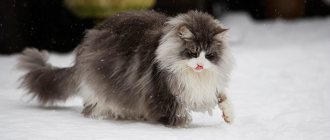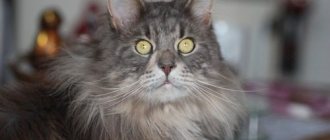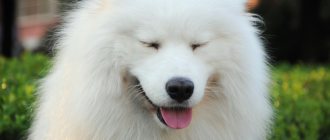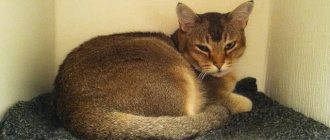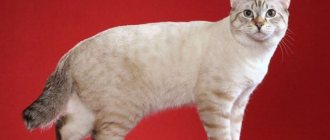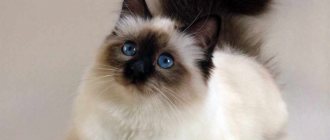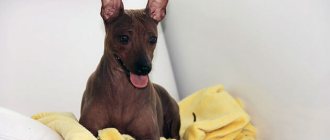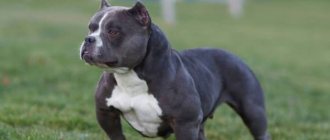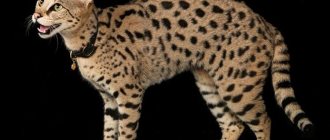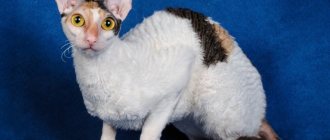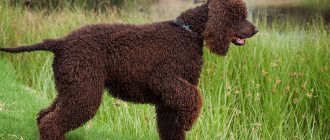History of the American Curl breed
All modern American Curls have a common ancestor - the cat Shulamith, picked up on the street in 1981 by a couple named Ruga. The spouses were pleasantly amused by the arched, as if turned inside out, ears of a mongrel kitty. But since the new owners were far from the subtleties of felinology, they were in no hurry to show the animal to specialists. In the same 1981, Shulamith acquired offspring. The father of a whole litter of purring fluffies was a mongrel and unknown cat. Nevertheless, almost all kittens born from him inherited their mother's curled ears.
American Curl
Joe and Grace Ruga were not ambitious, so at first they simply distributed the Shulamith babies to friends. However, in 1983, the couple turned their charges to a geneticist, who determined that the cat’s elegant “curly” ears were the result of a genetic mutation. Moreover, the gene responsible for this feature turned out to be dominant. This allowed Shulamith to enter into relationships with cats of any breed, producing babies with the same ear shape as her own. In the same year, Ruga's charges appeared at one of the cat shows held in California, which became good PR for them.
The American Curl breed received official recognition from TICA quite quickly - in 1987. At the same time, the “privilege” was granted only to semi-longhaired cats. Shorthaired Curls languished in anticipation until 1991, when the felinological organization finally decided to standardize them. It is worth noting, however, that the CFA recognized animals in both shorthair and longhair types, while the ACA and ACFA only did the same in 1993-1994.
Note: despite the fact that it is not customary to challenge Shulamith’s right to the status of the founder of the American Curl breed, it is worth clarifying that she was far from the only cat with such a mutation. Beginning in the 1960s, farmers in Oklahoma and California periodically encountered kitties with unusually fractured ear flaps, as evidenced by news reports from those years.
Appearance
Nature has endowed the Curl with a unique and unforgettable appearance.
What external data is considered normal:
- The head is wedge-shaped, without sharp bends or changes.
- The nose is short, slightly raised from the eyes to the forehead.
- The chin is strong.
- The ears are wide at the base, the tips of the ears are noticeably arched (90-180 degrees). The size is moderately large. It is desirable that tufts of fur be visible near the ears.
- The eyes are shaped like a walnut and are set obliquely. Eye color rarely depends on coat color and can range from blue to golden orange.
- The physique is moderately muscular, flexible and straight.
- The tail is flexible, widened at the base, length equal to the length of the body.
- The coat can be short or semi-long.
- The color can be anything from striped to spotted, with a moderate edge.
The most distinctive feature of this breed is, of course, their ears, which are slightly curled back. This unusual curl appeared as a mutation, but did not affect the pet’s health in any way.
The ear also feels different to the touch from the ear of a regular cat - there is more compacted cartilage, which allows it to maintain such an interesting shape.
The semi-longhaired breed's ears also have sharp tips, so these cats look more like a lynx.
In the photo the American Curl is shown as a semi-longhaired type:
American Curl breed standard
American Curl kittens
If in the story with the cat Matroskin, the identifying “documents” were whiskers, paws and a tail, then in the case of curls, ears alone are enough. The large, although not devoid of grace, “locators” of catfish from the New World form a noble curve, thanks to which it seems that the animal is constantly listening to something.
Head
American Curls have wedge-shaped heads with soft, smooth transitions. Representatives of this breed have a moderately long nose, a strong, well-defined chin.
Bite
Curls are characterized by a straight or scissor bite.
Eyes
Cats' large, slanted eyes have an elongated oval shape, commonly referred to as a "walnut." American Curl eye color is not tied to coat color and can be anything. An exception to the rule is individuals with color-point “coats”, whose iris should be bright blue.
Ears
The wide and large ears of American Curls are curved back and have a thin, rounded tip. According to the standard requirements, the angle of inversion of the ear cartilage must be at least 90°, but not more than 180°.
American Curl face
Frame
American Curls are distinguished by their plumpness and at the same time elegance of silhouette. The cat's body is flexible, rectangular, somewhat elongated, but quite muscular.
Limbs
The legs of American Curls are straight and of medium length. The paws are round, collected into plump “lumps”.
Tail
The tail of the American Curl is equal to the length of its body. In purebred cats, the tail is thick at the base, noticeably “thinner” as it approaches the thin, pointed tip.
Wool
Representatives of the long-haired variety of the breed have an airy, semi-adjacent coat, with a minimal amount of undercoat and guard hair. The neck and tail areas of cats are especially richly furred. The “outfit” of shorthaired Curls is less voluminous. They, like long-haired individuals, have virtually no undercoat, but the fur itself is more elastic and smooth.
Shorthaired American Curl
Longhaired American Curl
Color
In terms of colors, American Curls are allowed almost everything. Solid, Siamese, tabby, tortie, color point and bicolor - Curls made in the USA can have any of the colors, sometimes quite unexpected.
Disadvantages and disqualifying vices
At exhibitions, curls can qualify for a rating no higher than “good” if they have the following anatomical deviations:
- low-set, too steeply folded and directed anywhere but back ears;
- nose with a noticeable stop;
- too coarse or, conversely, cottony structure of the undercoat.
Individuals with too large a bend angle of the ear cartilage are not allowed to participate in exhibition events: when the tip of the ear touches the head. The same fate awaits Curls with too thick ear flaps, deformed cartilage (so-called “crimped ears”) and kinks in the tail.
Characteristics of American Curl cats
The friendly and affectionate American Curl fits well into a home where the owners tirelessly share their love and attention. Always ready to jump into your arms or press your head against the shoulder of your beloved patron, this cat will not appreciate prolonged loneliness. This can even have a detrimental effect on her nervous system.
Such a cat can easily replace even a dog. Demanding and attentive people will appreciate the willingness to train and learn. Curl is able to learn a lot, even pressing a button on a laptop to turn it on. The animal's intelligence allows the owner to conduct regular training, gradually and with encouragement teaching the cat to carry out certain commands. The first thing that a pet with beautiful ears will learn with interest is a request to bring a ball. Such a graceful American Curl cat will not miss the chance to have fun with his owner and play with him.
A representative of this breed is friendly towards children. Somewhat condescendingly, he will allow his fur to be ruffled. However, you should not leave your pet and small child alone unattended - the animal’s delicate ears can easily be damaged, because children are extremely fond of squeezing soft cats.
If a kitten of the American breed appears in your home, then you should immediately understand that although Curls have an easy-going disposition, curiosity can nevertheless drive the pet through the most secluded corners of the home.
The American Curl is very inquisitive towards its owners and is very attached to people. His direct participation in the life of the owners makes him a real companion and guardian of the family. With its soft purring, the cat will happily respond to affection and attention from its patrons.
The American Curl gives his heart not to his home, but to his owner, so he can happily take part in the journey.
Photo of American Curl
Cost of kittens
How much does an American Curl cost? In our country, on average across regions, purebred Curl kittens cost at least 3 thousand rubles.
The price of an American Curl varies depending on the sex of the animal, its pedigree, possible participation in exhibitions, and breeding qualities. So the cost can reach up to 60 thousand rubles.
American Curl Personality
American Curls are the cutest creatures with an extraordinary appearance and angelic character, whom you just want to squeeze into your arms. Unlike most other representatives of the purring brethren, they are completely devoid of arrogance and militant independence and are truly attached to humans. To get along with an American Curl, you don’t have to take any special actions. This little eared dog loves its owner by default, but in turn expects the same manifestation of feelings from him. Most American Curls are sociable, curious cats who prefer to spend their leisure time in the company of a person. They will willingly surf the Internet with you, correcting the movements of the computer mouse with their furry paw, help you knit (or untie) another napkin, or simply lie on the sofa at your feet. However, one should not confuse the desire for close physical and emotional contact with obsession, which is absolutely not characteristic of curls.
How about a little attention?
The American Curl is one of the cat breeds that does not cope well with loneliness. Yes, a cat is capable of entertaining himself, but communication with a person cannot be replaced by either a mountain of goodies in a bowl or the most expensive gaming complexes. So before you buy a cat, think carefully about whether it will fit into your work schedule. The balance and natural calmness of American Curls allows them, if not to be friends with other domestic animals, then at least not to conflict. It’s hard to imagine what something so terrible would have to happen to make these good-natured purrs extend their claws and hiss threateningly at the dog or cat living in the same house with them. But kitties, as a rule, do not stand on ceremony with small animals. Hunting instinct - nothing can be done.
Another distinctive character trait of American Curls is the ability to painlessly adapt to the changing conditions of the surrounding reality. These cats adapt quickly and withstand moving and traveling relatively easily. Curls are also not irritated by noise effects, so if you throw a Friday party in your own apartment, the cat will not only not be scared, but will also try to take an active part in the festive event. The American Curl will also easily find an approach to guests who appear on the doorstep of the house, demonstrating its own disposition by quietly purring and cutting circles at the “newcomer’s” feet.
Choosing a kitten
Before getting a kitten of this wonderful breed, carefully weigh your options. The fact is that the sociable Curl does not tolerate loneliness: being left alone at home for a long time, he will soon begin to feel sad and may even become seriously ill. It’s better not to get such a pet if you can’t provide it with constant human contact.
It is curious that American Curl kittens are born with the most ordinary, straight ears, but from about the fourth day they begin to gradually curl. This main breed characteristic is finally formed by the age of four months, when it is recommended to adopt a kitten.
A newborn Curl's ears are straight, like a regular kitten's.
While the baby is growing, his ears-"horns" behave unpredictably: they curl up, then suddenly straighten. Therefore, curl breeders sell their pupils later than most other breeds. The ear cartilage must be fully formed - after all, not only its purely monetary, but also its breed value depends on how the American Curl's ear becomes.
The baby curl is an adorable creature with curled ears.
Do not expect that you will be able to purchase a representative of this rare breed “cheaply” - even a Straight-Eared Curly who has unexpectedly found its way into the litter will not cost less than three hundred dollars, the price of pet-class kittens starts from this amount. And their promising brothers and sisters will cost buyers a thousand dollars or more - beauty requires money. Keep in mind that keeping such a cat is also not cheap: responsible owners spend at least fifty dollars a month on their pet - despite the fact that curls are really quite unpretentious.
There are many obvious advantages for the buyer in purchasing a fully grown kitten, older than four months . By this time, the animal has undergone full vaccination and quarantine, which means it can move to a new place of residence without any health risks and come into contact with any other pets there, if any.
When you buy a kitten from a professional nursery - and that’s the only place you should buy an American Curl - you can be sure that it is fully socialized and accustomed to all the nuances of a problem-free life in the family. In addition, the breeder will be able to tell you a lot about the behavior, character and preferences of this wonderful eared dog.
Every Curl litter has colors to suit every taste.
The Curl is also good because, unlike many other breeds, scammers here will not be able to deceive you. The main breed characteristic is visible to the naked eye even to an amateur: the ears are either curled or not - there is no third option. However, beware of spontaneous purchases of curls on the Internet, pet stores, and even more so at bird markets. The biggest risk of such an acquisition is that you can get a sick animal with all sorts of sad consequences arising from this fact. And of course, when selling a kitten as a “show class”, no one can guarantee you anything.
Yes, the baby will cost you more at the nursery. And if you are serious about your pet’s exhibition career and breeding activities, then it is very expensive. Delivery of an animal will also cost a lot if you buy it from a foreign, and even more so, from an overseas nursery. But such a cat should be purchased under an official contract with the breeder, which determines not only the rights and obligations, but also the responsibility of both parties in various emergency situations.
Give your pet as much attention as possible
The breeder is always interested in the future of his kitten. Therefore, as a bonus, you will also receive a lot of really valuable recommendations, and ideally, long-term help: advice on raising, treating and caring for your wonderful curl. The main thing that is required from you is love, attention and care.
Video: Mom's tail is a great toy
Education and training
American Curls have a somewhat “dog-like” character. In other words, this is a breed that can be raised “to suit you” and even taught some tricks. The main thing is not to make excessive demands on the mustachioed good fellow, because he is just a cat and, in general, he has paws. However, learn individual dog commands, such as “Come to me!” or “You can’t!”, kitties are able to.
We're sitting well
When training an American Curl, it is necessary to take into account the mental characteristics of cats as a whole. For example, never repeat a command several times or modify it. An animal simply will not understand you if today you order it to “Sit!”, and tomorrow you simply invite it to “Sit!” Commands should be given in a soft but convincing tone. Remember, cats are not dogs and will not allow you to push them around. Give up the method of negative reinforcement in favor of positive one: give your American Curl treats even when he hasn’t coped with the job and be sure to praise him. And of course, don’t delay your upbringing: the older a Curl gets, the more difficult it is to convince him of the need for training. Yes, he may be the universal cutie and the most good-natured pet in the world, but this will not stop him from shirking his classes and turning on the “invisibility” mode.
How to care for an American Curl
The care requirements for American Curls are minimal - this elite breed is extremely simple and unpretentious in maintenance. So much so that even a novice cat lover can handle it.
Hygiene
Of course, you will need to regularly comb their beautiful coat, this is especially true for long-haired Curls. They need to be bathed when they get dirty or once every two to three months. Playful curls even turn the washing process into fun - they like to catch streams of water and play with splashes.
If you consider too frequent bathing undesirable, then you can use dry shampoos if necessary - the modern pet industry offers a huge selection of them.
The American Curl's silky, practically devoid of fluffy undercoat does not form tangles and does not bunch into felt, which often happens in other long-haired breeds. Usually one brushing a week is enough to keep the coat in good condition . When a cat sheds, you will, of course, have to brush it more often. During these periods, in addition to the slicker, you will also need a good furminator - with it, the procedure for getting rid of dead fur will be faster and more effective.
The Furminator should only be used during molting periods of the American Curl.
If a curl walks a lot, its claws wear down naturally; a good scratching post can also help in this matter. In all other cases, overgrown claws need to be trimmed from time to time - about once a month. Your pet's eyes and teeth also require regular hygiene . For a healthy cat, it is enough to wipe its eyes daily with a cloth soaked in boiled water. If there is heavy discharge, you should see a veterinarian to determine treatment or a more effective care product.
The situation is the same with the dental system: root plaque on the teeth and bad breath in a cat can indicate both an incorrectly selected diet and chronic internal diseases, for example, problems with the gastrointestinal tract. The cause requires identification and elimination, but teeth should be brushed in any case. To do this, you should purchase a special - not human - toothbrush and toothpaste.
Some owners brush their pets' teeth with crushed activated carbon, which also gives a good effect.
Curl ears, of course, deserve special attention. They need to be carefully inspected at least once every two weeks. If there is contamination, carefully clean with a napkin or cotton pad and warm water. It is not advisable to use a cotton swab, nor is it recommended to try to deeply clean the auricle. If the ear turns red, becomes hot, or has an unpleasant odor, this is a signal to urgently consult a doctor.
Video: features of caring for a curl
Nutrition
Curls love to eat a lot and deliciously, but at the same time they are by no means spoiled gourmets and consume both ready-made dry food and canned food, as well as natural food, with equal enthusiasm. Typically, breeders recommend keeping representatives of this breed on ready-made super-premium food, and this advice is worth listening to. After all, you are buying a kitten that has already grown up, which is accustomed to specific types of food, and its fermentation has developed in a certain way.
Moving to a new family in itself is stressful for any animal, and it should not be aggravated by a sudden change in diet. Even if you are a staunch supporter of natural nutrition, transfer your pet to it smoothly and gradually, starting with the types of food that are familiar to him. The natural diet of the American Curl should be varied, but not too high in calories. What can be included in its menu:
- chicken breasts;
- lean red meat - preferably veal;
- offal;
- boiled sea fish;
- skim cheese;
- eggs - quail eggs are better;
- well-cooked rice or buckwheat porridge - in small quantities;
- vegetables and fruits - except citruses and grapes.
A balanced diet is very important for the Curl.
What not to do:
- milk and cream;
- any legumes;
- dried fruits and citruses;
- fatty, spicy and fried foods;
- sweets and confectionery;
- fresh yeast baked goods;
- “goodies” from the host’s table.
Toilet
Ask the breeder what type of litter box your pet was accustomed to and what type of litter he used. The toilet is a delicate matter, and it will be better if your little newcomer does not experience any sudden changes in this matter.
In general, a closed tray, or at least one with high sides, that is quite spacious, is preferable. Having settled into a new place, the fidgety Curl will begin to show its playful nature in the most unexpected places - even in the toilet. A cramped open tray means guaranteed heaps of garbage on the floor next to it, or even throughout the house.
Choose the highest quality types of litter - medium-sized mineral or silica gel granules are usually most suitable for curls. But it is not advisable to use cheap wood fillers, especially if your pet has long fur.
Exercise
Be sure to purchase a comfortable harness for your pet and start teaching him to walk on a leash as early as possible. Walking for these cats is both pleasure and great benefit.
Curls willingly walk on a leash and even obey the command: “Nearby!”
Go for a walk with your pet at least twice a week in any weather. But don’t risk letting him off the leash - if he gets carried away by something interesting to him, the curl can run away, and it will take a very long time to look for him.
Outside the home, many dangers await the trusting curl - he is not afraid of anyone, moreover, he strives to communicate with everyone he meets, be it a stranger, a cat or a dog. And some of these meetings can end in tears for your baby. Be especially careful on the roadway and parking lots - many curls even perceive cars as living beings... and immediately rush towards them to get acquainted.
Maintenance and care
The American Curl will need the same belongings as any other cat. In particular, for a purr you will have to purchase a bed or house, toys, bowls for food and drink, a carrier, a tray, and also a harness for walking. The house will also have to be put in order before the kitten moves. Remove any small objects from the floor that the baby might want to taste, and securely hide household chemicals, shoes and wires from household appliances.
Up to a year old, American Curl kittens suffer from excessive curiosity, which drives them to window sills, to open windows, into the drums of washing machines, ovens and trash cans, so at first it is better to carefully monitor the movements of the mustachioed lawless guy around the apartment. You can take an American Curl kitten outside no earlier than 2.5-3 months, and then only if the animal is vaccinated and dewormed. Adult cats are walked twice a day on a harness. The breed is considered active and playful; it needs constant fresh impressions, which can only be obtained outside the apartment; accordingly, it is wiser not to neglect the pet’s daily walks.
Oh yeah! Scratch me completely
Hygiene
The coat of the American Curl does not mat and hardly tangles, so a simple combing with a fine-toothed comb and a stimulating massage with a natural bristle brush is enough. Both short-haired and semi-long-haired individuals are combed using the same set of tools, but with different frequencies. In particular, it is recommended to comb the coats of short-haired Curls once every 7-10 days, and twice a week for long-haired Curls. American Curls shed seasonally and during such periods it is better to increase the amount of brushing: it is beneficial for the pet and there is less hair in the apartment. Sometimes a slicker is used to remove dead undercoat, which is insignificant in the breed.
Give me your paw!
It is better not to overuse bathing: two or three times a year is enough for the American Curl. They wash the purr with zoo shampoo, which is best selected with a cat cosmetics consultant. To give the coat a pleasant shine and make combing easier, it is advisable to use conditioner. Dry short-haired Curls with a cotton towel, and dry long-haired Curls with a hairdryer. In the intervals between baths, cats can be dry cleaned, for which it is worth purchasing powder and powder shampoos.
It is also necessary to clean the ears of American Curls, but due to the unusual structure of the ear funnels, this should be done with extreme caution. The ear cartilage of kitties is dense and easily breaks if you put too much pressure on it. Typically, the ears of American Curls do not produce much secretion, which looks like a dry dark coating, which is recommended to be removed once a month. It is better to examine your eyes daily. Representatives of this breed do not suffer from excessive lacrimation, but the tracks and lumps in the corners of the eyelids, of course, do not decorate the animal. So in the morning, wipe the corners of your Curl's eyes with a damp cloth.
It is better to brush your teeth once every couple of weeks. To do this, you will have to stock up on a cleaning composition from a veterinary pharmacy and a cat toothbrush. If for some reason such things are not available, you can limit yourself to a piece of gauze wrapped around your finger and baking soda. Even if a Curl has ten scratching posts hanging throughout the apartment, it is still necessary to trim his “scratches”, since in representatives of this breed they often grow into the pads. The only point: if you do not have experience in trimming claws as such, it is advisable to read the step-by-step instructions before the procedure, otherwise you risk touching a blood vessel in the claw and injuring your pet.
Feeding
Where's my food?
American Curls have an enthusiastic and reverent attitude towards food. Purrs with “twisted” ears love to fill their bellies, sometimes with things that are completely unsuitable for them. Don't be fooled by your pet's pleading looks and don't put a spoonful of roast or a piece of pie in his bowl. Firstly, because food from the table is unlikely to be appreciated by the cat's digestive system. And secondly, because such indulgences undermine your authority in the eyes of the animal.
American Curls should have their own “cuisine”, the basis of which is either high-quality super-premium “drying” or natural products. Moreover, in the second case, you will have to rely on lean meat (poultry, lamb, beef) and offal. Once a week you can treat your mustachioed gourmand to pork or beef cartilage (no fish or chicken bones). Suitable additions to the basic diet include oatmeal and rice porridge cooked in broth, low-fat kefir, fermented baked milk and cottage cheese. Vegetables are given to American Curls only in boiled or stewed form. These are mainly carrots, pumpkin, zucchini and beets. And of course, don’t forget about vitamin supplements with calcium, which help balance your pet’s natural diet.
How to feed an American Curl
Up to 6 months, kittens should eat 4-5 times a day. Six-month-old adolescents are fed 4 times and so on for up to a year. Starting from 12 months, the American Curl eats three times a day, since the transition to two meals a day occurs no earlier than by one and a half years.
Curl health
Many elite cat breeds have inherited a large number of genetic health problems, including serious ones, from their ancestors. This does not apply to curls. The only hereditary deviation they have is the special structure of the auricle.
These animals have strong, good immunity; with proper nutrition and maintenance, they cope well with most diseases. Do not think that this applies to dangerous infectious diseases. Vaccination must be carried out.
Curls interbreed with regular mongrel cats and male cats. This has a positive effect on the gene pool of the breed, eliminating the possibility of any problems for them.
Curls live on average 15 years, but there are individuals whose age has exceeded 20 years.
A common problem these animals face is due to the structure of the ear canal. It can lead to inflammatory processes. In this case, it is necessary to contact a veterinarian; self-medication is strictly not recommended.
Vaccinations and antiparasitic treatment
Any cat, even with the best immunity, is unable to resist viral infectious diseases, many of which are lethal.
In this case, be sure to vaccinate your pet against: To ensure that the pet itself does not suffer from parasites and also does not pose a threat to humans, including children, it is important to carry out periodic treatment against helminths. These events should be carried out once every 6 months, repeated after two weeks. To combat fleas and other insects, there are special collars, drops on the withers, and shampoos.
What you should know about knitting
In order for mating to occur without problems, it should be carried out only after the onset of puberty - 1.5-2 years. The American Curl breed has some features of its breeding that people planning to do this need to know. For this purpose, individuals of the same breed or having similar features among outbred felines are selected.
This condition is intended to introduce diversity into the gene pool. If mating took place between two pure Curls, all offspring will have a special ear structure. In case of participation of outbred animals – 50%.
All newborn kittens are born with the most ordinary ears; the transformation begins after a few days.
Sterilization and castration
If the Curl owner does not plan to become a breeder, it is advisable to sterilize the male cat. This operation is performed only in a clinical setting, under anesthesia. Afterwards, special care is required for several weeks. This manipulation is carried out over a period of 7-9 months.
How to choose a kitten
I'm already chosen
- Even in litters of famous curls with champion diplomas, babies with straight ears can “slip through the cracks.” And if a breeder shows you a flock of cats in which, along with “bow-eared” purrs, straight-eared cats run around, this is not yet a reason to suspect the cattery and its owners of all mortal sins.
- American Curl kittens rarely inherit the parental degree of ear curl. Accordingly, if when meeting a mother cat you find that her ears are not that curled, this does not mean that her offspring will have a similar feature.
- It is wiser to adopt American Curl kittens at the age of 2.5-3 months. The rather late date is explained by the fact that during the first weeks of life, the ear cartilage of babies is unstable and often changes the angle of inversion.
- Choosing a kitten with the steepest ear curl to ensure future access to exhibitions is an unnecessary safety net. This parameter has absolutely no effect on the show karma of the American Curl: individuals with a slight bend in the cartilage (but not less than 90°) often become champions.
- Check that the selected kitten has the necessary documents (metrics, veterinary passport), as well as the presence of an electronic chip on its body.
Catering
Curls love to eat, and they are not particularly picky: they will not disdain to get into a trash can, and they will try to steal a piece of wrapped meat from a bag. And this is fraught with serious stomach problems. When choosing a nutrition system - whether a natural menu or ready-made food - remember that the food must be balanced, the products must be fresh, and the portions must be appropriate to the physical condition and age of the animal.
Babies eat at least 6 times a day, teenagers (at 4-5 months) - 4 times, over six months - 3 times, from one and a half years - 2 times: in the morning and in the evening. Bowls are washed after every meal. The water is also changed 2 times a day.
Natural products
- The basis of the Curl diet is meat (veal, rabbit, beef, turkey) and offal (stomachs, hearts, liver). The meat is not boiled, but defrosted and doused with boiling water. Offal can be stewed or served raw.
- 4-5 times a week cats are fed porridge cooked in water: rice, oatmeal, millet, buckwheat. Liquid semolina porridge with milk can be given to babies.
- Add boiled chicken egg white to the porridge 1-2 times a week. Quails are crushed whole.
- Vegetables (carrots, zucchini, pumpkin, cabbage, beets, green beans) are stewed, but if the cat wants to chew on a raw cucumber, do not forbid it. Cucumbers, like melons, are allowed.
- Almost everything can be given from dairy products: cottage cheese, sour cream, cream, kefir, natural yogurt, Varenets, yogurt, unsalted cheese. Choose products without dyes, flavor enhancers and other harmful additives.
What is it forbidden to give to Curls?
- Fatty meat: pork, lamb, goose and duck. It takes a long time to digest, and in addition, it is often contaminated.
- Fish (both sea and river).
- Whole cow's milk (if the Curl has not been accustomed to it since childhood).
- Tea, coffee, cocoa, juices and sparkling water, alcohol.
- Smoked, flour, sweet, salty, sour.
- Citrus fruits, avocados, eggplants, tomatoes, potatoes, legumes (chickpeas, peas).
- Dog food, human canned food, sausages, sausages, tripe.
- Bones, lard.
Recommended food
When giving preference to industrial feed, choose either super-premium or holistic feed.
- Holistic: Naturea, Now Fresh, Wellness CORE.
- Super premium: Husse, Ontario, Matisse, Meglium.
Below are recommended super-premium foods. Links with the names of the food are clickable, on them you can, within our website, get acquainted with the descriptions of the food and read reviews from owners of American Curl cats.
| Holistic | Super premium | Super premium |
| Savarra | Mera Finest Fit | Happy Cat |
To cleanse their stomach, wild cats eat a certain kind of grass that they find in the meadows. For pets, you can grow wheat or oats at home.
Pictured are kittens of the American Curl breed.
American Curl kittens
Interesting Facts
During the short period of existence of the breed, many interesting things have been associated with it:
- Although the Shulamith cat is considered the ancestor of the American Curl, she was not the only one who had this mutation. Since the 1960s, farmers in California and Oklahoma have regularly seen animals with unusually broken ears. This is confirmed by news reports at the time.
- The degree of curl, which determines the breed qualities of the American Curl, does not depend on how curled the ears of the parent pair were. Often, two champions produce pet-class kittens. And vice versa, a couple with a weak break in the ear tissue produces beautiful offspring.
- American Curl kittens are born with straight ears. The web begins to curl around the 4th day and is finally formed by 4 months of age.
- The American Curl served as the basis for the development of a new breed. From its crossing with the Cornish Rex, the Raffle Rex was born.
Character and temperament
The American Curl cat has a calm, friendly disposition and good adaptability. He is not very demanding, but loves to play and needs attention from his owners.
An important characteristic of curls is their poor tolerance of loneliness. Of course, in the absence of communication with people, the animal will find something to occupy itself with, but it is unlikely that its owners will like its entertainment. Therefore, cats with curled ears should not be left unattended for a long time.
Breed and children
The American Curl is a sociable and very peaceful cat that easily finds a common language with the owner’s children of different ages. He loves to play with kids, especially if they don't hurt him.
Breed and other animals
The American Curl has a calm, balanced character. And this allows him not to conflict with other pets. He gets along well with cats and dogs, but due to his developed hunting instinct, he is not able to peacefully coexist in the same territory with small animals.
